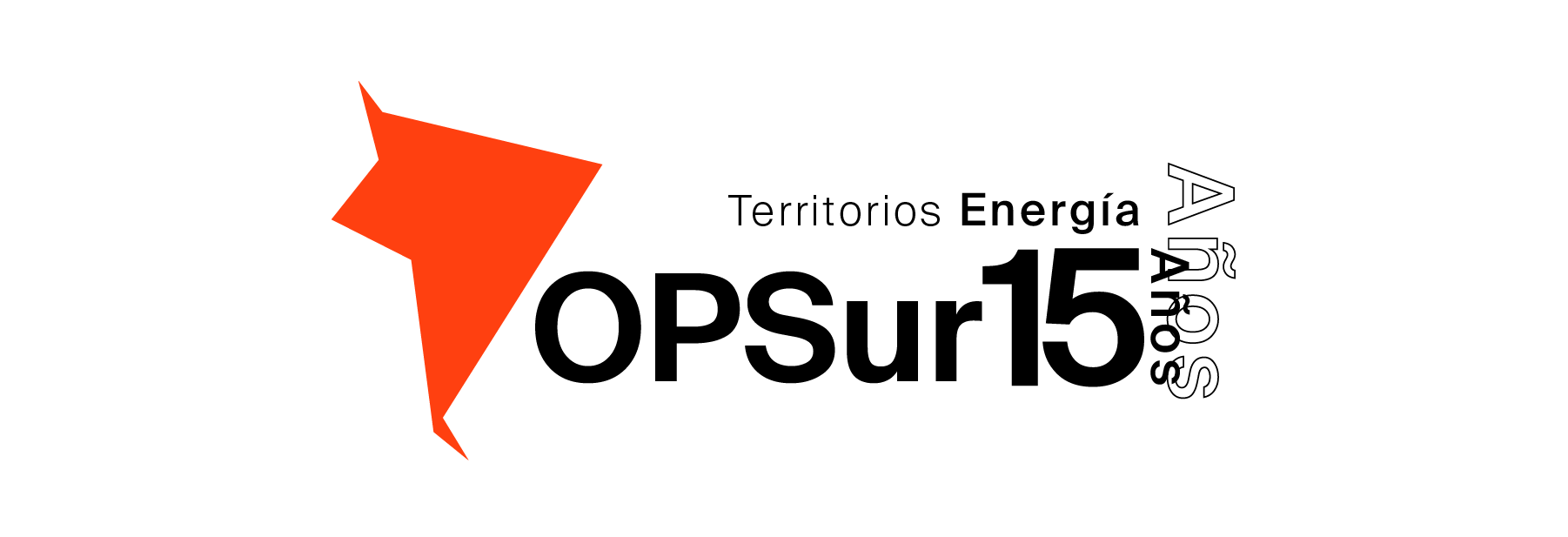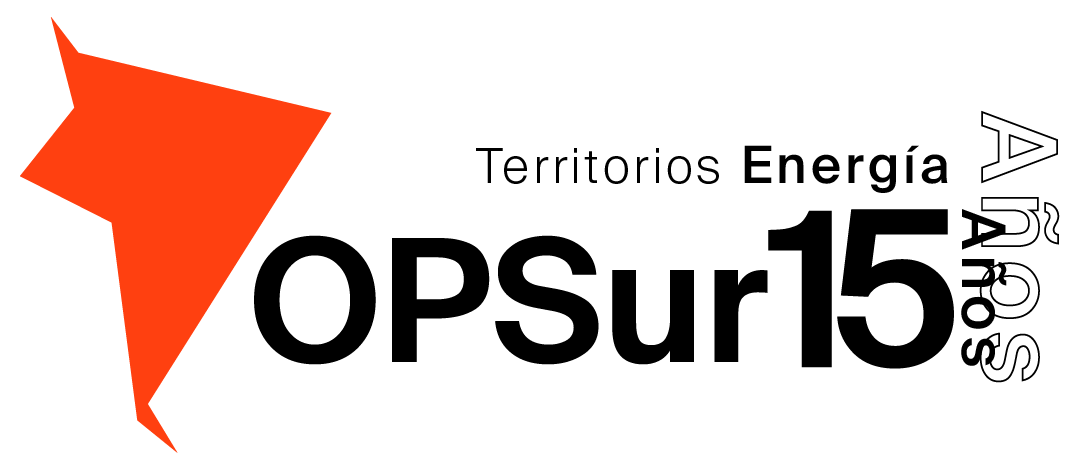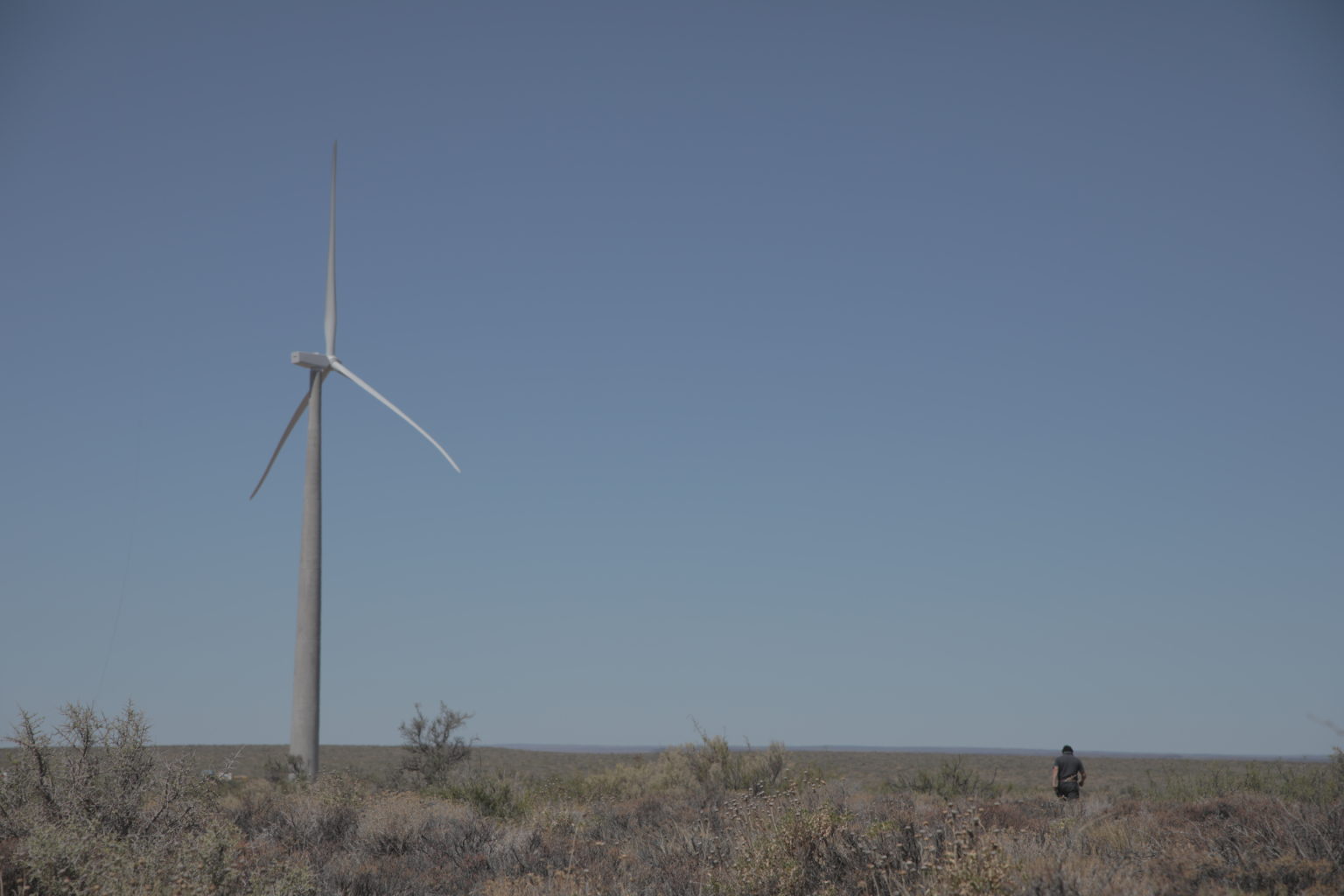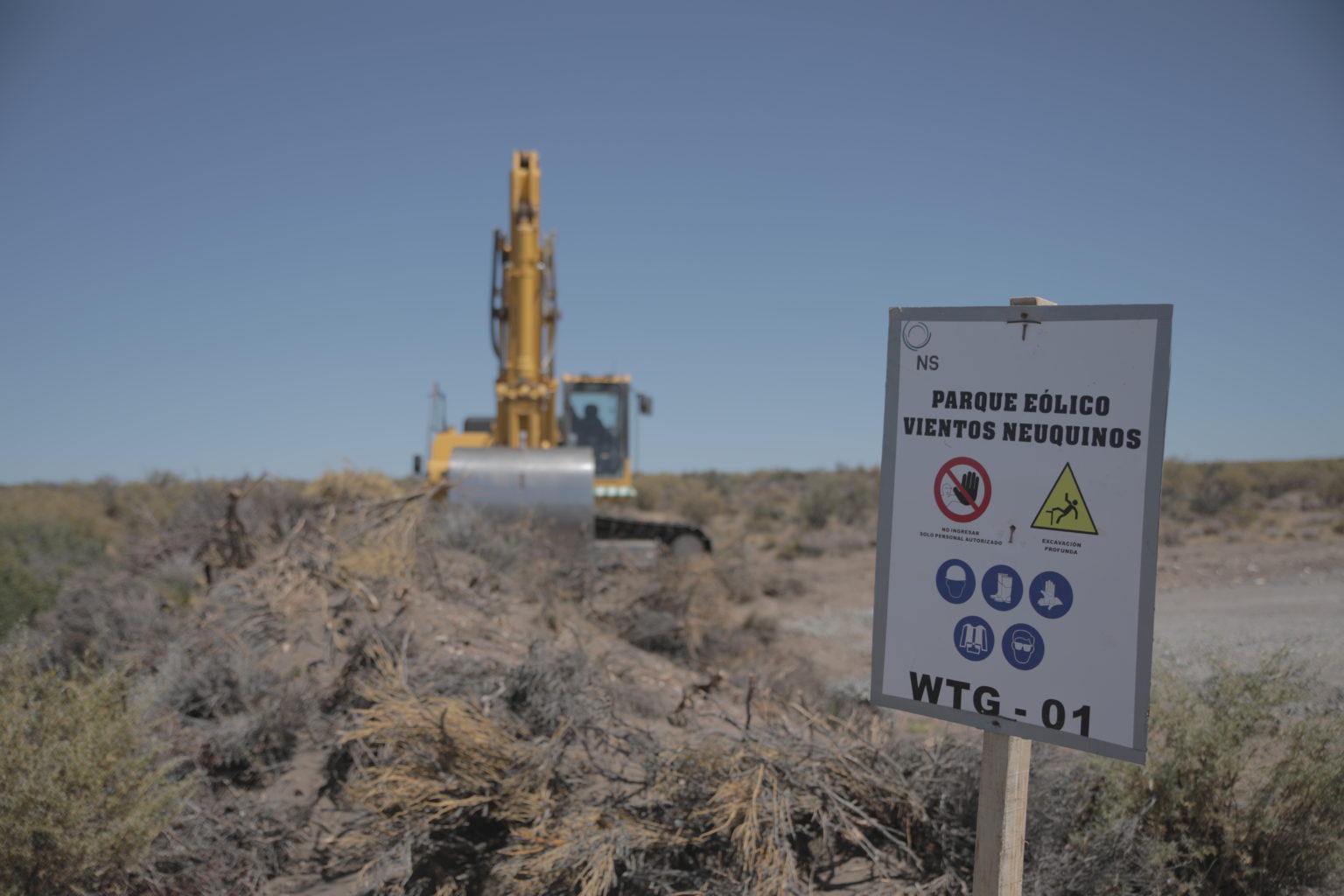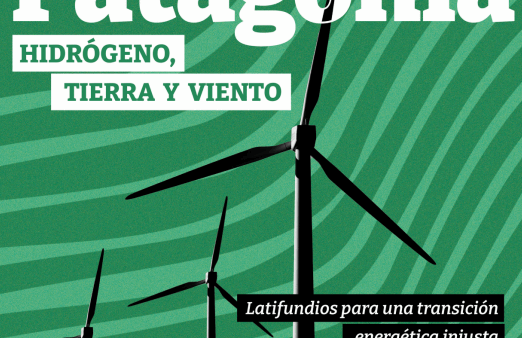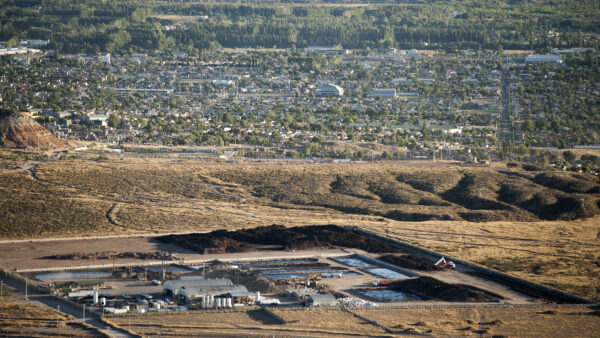Vientos Neuquinos I (Neuquén Winds) is the first wind power farm inaugurated in the province of Neuquén, among many still in the pipeline. With the launching of this project, green bonds became available in the Buenos Aires stock exchange. Prior to its construction, the provincial government concealed the fact that the place where the wind turbines were installed has been the home of the Cárdenas Rañileo family for more than a century. It was an excellent opportunity to facilitate the coexistence of small-scale livestock breeding and wind power generation, but the authorities applied the same rationale of dispossession with which they enforce hydrocarbon exploitation in the province.
By OPSur / Translated by Laura García / Ph: Marco Dreyer .- Bajada Colorada is a rural outpost located 190 km to the south of Neuquén city on a national route that connects that city and the touristy Bariloche. This is where Venancio Rañileo settled in the 1890s, and where he began goat farming, as was the tradition in that territory. In 1932 his son Luis, who continued with the family tradition of small-scale goat farming, submitted a request to the corresponding State agency, which was then the National Territory Office, to obtaini the first license of occupation of the area. Later on, his granddaughter María Teresa began the process of claiming the land title of the estate in the 1980s. There, among the bushes of jarilla and zampa, native vegetation of the Neuquén hills, Venancio’s great-grandsons continue breeding goats in a 17,000-hectare field today despite still being unable to obtain ownership of the estate, as is the case with a great number of public lands in the province.
The wind power farm Vientos Neuquinos I, with an installed capacity of 100 MW, occupies 2,603 hectares, part of which includes the land occupied by the Cárdenas Rañileo family (1). This is the first project promoted by the Investments Development State Agency of the Province of Neuquén (ADI-NQN) that has been set in motion, while seven more are still in the pipeline. The project began as an initiative of the State of Neuquén and was sold to the U.S. company AES in 2018. It was inaugurated on XXX.
After two failed attempts at entering the RenovAr plan, the project became part of the Renewable Energies Forward Market (MATER), which aims at supplying large energy consumers through direct selling from the energy provider. It is essentially an agreement between private parties. In the context of a much needed but slow transformation of the national energy matrix, this powerhouse certainly is a contribution to the efforts in reducing the relevance of hydrocarbons, which today represent almost the whole of the primary energy sources. However, as with other renewable energy projects, the rationale is to commodify the right to energy.
Walter Cárdenas Rañileo has settled his house right beside the place where his great grandfather’s house used to be. A thousand meters from which was installed one of the wind turbines of Vientos Neuquinos. Cárdenas holds the province responsible: “They told the company that nobody lived here and these were vacant and unproductive fields so they could come in and work at ease. They also said we didn’t want the farm built but we were never against the farm. Have it built, but take us into account if you do. Of the 200 mothers I used to have, big nanny goats, now there are hardly 50 left”, he tells us while pouring water into his mate inside his settlement. “This windmill next to us will cast a shadow and blow wind in my ears. They say no one’s here, and yet they almost built the windmill inside my house”, he adds laughing.
The boost of wind power in Neuquén
Mapping the distribution of wind power in the province was the first step in developing the project. The Provincial Energy Entity of Neuquén (EPEN, for its Spanish acronym) gathered all the necessary information in order to facilitate the technical and economic analysis of different energy supply alternatives and to identify potentially suitable areas for project development. The final report was presented in 2006, and thus the wheels were set in motion.
Three years later, governor Jorge Sapag issued decree number 1837/09, which declared wind power generation of public interest in four areas selected by the ADI-NQN—three were located around the city of Zapala and one in the area surrounding Picún Leufú. The law requires the interests and desires of the affected legitimate land occupants to be considered, and requests the enforcement authority of the provincial act number 263—the Provincial Lands Office in this case—to constitute the easements needed for both the development of the activities and the installation of the wind turbines.
The then president of ADI-NQN, Pedro Salvatori, in declarations for Neuquén Informa highlighted as an innovating aspect of the decree that “since these are public lands, once the suitability for wind power generation is verified the interested parties will be able to make their investments with a right of easement, paying just a fee designated by the State of Neuquén. This benefit will not be obstructed by temporary illegal occupants, or those with precarious land tenure”(1). In view of the facts, these statements reveal that the government was aware that the project was treading on thin ice given the lack of regularization in the tenure of public lands in the province, but instead of solving the issue of land occupation chose to defer it by decree leaving the door open for conflict.
In April 2012, ADI–NQN and the company Emprendimientos Energéticos y Desarrollo S.A. (EEDSA) formed Vientos Neuquinos S.A. In its Environmental Impact Study (EIS) of the wind farm Vientos Neuquinos I, the enforcement authority made an observation regarding the overlapping and compatibility of wind and hydrocarbon power generation activities. The Secretary of Environment noted that the parcel of land where the wind farm would be placed overlapped with two hydrocarbon areas and that the Cordillerano gas pipeline runs through these lands, and therefore demanded that there should be a permanent communication between the companies and the Undersecretary of Hydrocarbons. The Provincial Office of Water Resources, the Provincial Entity of Water and Sanitation and the National Administration of Civil Aviation were also allowed to intervene. But at no point was the Provincial Lands Office called for intervention regarding the century-old occupation of the land by the Cárdenas Rañileo family, who was not only ignored but also made invisible in the EIS.
On October 12th, 2017—a more than emblematic date—AES Argentina Generación and AES Electro Inversora España SL signed an offer letter for purchasing Vientos Neuquinos I. AES Argentina, subsidiary of The AES Corporation, operates in the country since 1993 and is one of the main firms of the electric sector in the country, with 12 power generation plants located in the provinces of Buenos Aires, Río Negro, Neuquén, Salta and San Juan, and an installed capacity of 4.168 MW, which represents 13% of the total installed capacity of the country. In July, 2018, the U.S. subsidiary made an irrevocable purchase offer for USD 3.168 billion for the total shares and the voting rights in the Vientos Neuquinos I project (3).
The initial project entailed the construction of a wind farm with a capacity of 80 MW with an estimated investment of USD 104 million, but in September 2019 AES was granted a loan for USD 122.6 million from the Overseas Private Investment Corporation (OPIC) and thus decided to increase the installed capacity to 100 MW.
A bumpy road for the Cárdenas Rañileo family
The Cárdenas Rañileos’ existence was only taken into account by the Province and the company when the family prevented machinery and workers from entering their land without permission. In a provisional measure, the Province argued that “around 800 hectares of unproductive public lands were being put into use” (4). For the Cárdenas Rañileo family, the main conflict with the wind farm arises from the difficulties to maintain their goat farming activity with roads being opened and machines and trucks constantly moving around. During the year, the family herds the goats throughout the fields to procure the best fodder. It is precisely in their winter grasslands, where the goats spend both their pregnancy and calving periods, that the 29 wind turbines are being installed.
A veterinary clinical report by Dr. Gustavo Foricher shows that the constant movement of machinery “allows to conclude that the field cannot be used on a regular basis for extensive goat farming as it traditionally was”. The study adds that the change brought about by the wind farm causes stress in the animals, which in turn alters their behavior, scatters them and leaves them vulnerable to the attack of predators like foxes and pumas. This stressful situation has also affected the mothers, with several cases of miscarriage and premature deaths of calves caused by malnutrition. According to Walter, the problem is “all that noise and mess they make. The animals are not used to it. I was going crazy—I didn’t know what to do, how to handle the animals, I felt embarrassed to say I was a peasant. Because every two or three days I had to bother the neighbors by telling them—’Hey the goats ran away again, get a hold of them if you see them around please’. And that’s how the animals ended up scattered”.
While the State denied and concealed the Cárdenas Rañileos, the company moved forward. The family lodged a formal complaint with the Provincial Lands Office, which led to the establishment of a negotiation instance with the company at the beginning of 2019. However, the lack of response has led the family to think this avenue is exhausted. In June of the same year, governor Omar Gutiérrez laid the foundational stone of the project, and two months later the family decided to close the field gates and prevent the workers from entering Vientos Neuquinos I.
Walter Cárdenas emphasizes how the provincial government first and the company after adopted an attitude of expulsion towards his family and their productive activity, but does not question the possibility of coexistence between small-scale goat farming and the development of the wind farm: “We told them they should have let us know before. We could have prepared another field for wintering before all the mess started, because it’s not like we can move the animals around and just tell them to stay there. No, we have to adapt them, have them develop an attachment to the place, and that is a daily job. That’s why they did everything wrong”.
Green bonds
In February, AES Argentina Generación placed the first green bond in the Buenos Aires stock market in order to finance the completion of the wind farm Vientos Neuquinos I. This way the company acquired USD 48.4 million. Green bonds are instruments destined to finance projects related to renewable energies, pollution prevention, biodiversity conservation, clean transportation and water defense, among other goals defined by the International Capital Market Association (ICMA). The negotiable debt securities issued by AES Argentina followed the 2018 Green Bond Principles (GBP) of ICMA and the Guidelines for the Issuance of Social, Green and Sustainable Marketable Securities in Argentina of the National Securities Commission.
In the prospectus of the negotiable debt securities issued by AES Argentina published on February 10th in the Buenos Aires Stock Exchange daily newsletter, the company states that the project adheres to the guidelines because it contributes to reducing fossil fuel dependence as well as toxic and greenhouse gas emissions, and in addition it does not generate dangerous byproducts.
Besides the obvious allusion to its “clean” aspect, they emphasize: “According to the EIS, there are no indigenous communities near the project site that could be affected by its development. The closest ones are three communities located at a distance of 37, 67 and 71 km respectively from the project site. None of these is in possession of land titles or has laid claim on any of the lands where the Eligible Green Project is being developed”. Strikingly enough, the company only focuses on indigenous communities, as if these were the only ones that can be affected in a rural outpost. Moreover, it only refers to the EIS, disregarding all the events that took place since the works began. When the green bonds were issued in February 2020, the conflict with the Cárdenas Rañileo family was not only well underway, but had also been taken into court.
In the prospectus, AES Argentina highlights that through implementation of the Environmental and Social Management System, “a good relationship with the communities is achieved, social unrest is prevented and the image and credibility of AES before stakeholders and key social actors is improved”. It seems this might not always be the case.
Related articles
“Energías renovables: un plan a medida del mercado”
Sources:
(1) Parque Eólico Vientos Neuquino. (Non-technical summary)
(2) Neuquén Informa (09/27/2012). “Neuquén convocó a inversores para medir el recurso eólico en tierras fiscales”.
(3) AES Argentina Generación. Estados Financieros Intermedios Condensados. (Summary Intermediate Financial Statements for 9-month period ended on September 30, 2018)
(4) Noticias Nqn (12/11/19). “Parque Eólico Vientos Neuquinos: El Juez hizo lugar a la cautelar y citó a las partes a una audiencia”.
